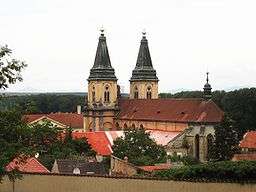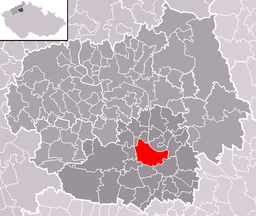Roudnice nad Labem
| Roudnice nad Labem | |||
| Town | |||
 Church of the Nativity of Virgin Mary | |||
|
|||
| Country | Czech Republic | ||
|---|---|---|---|
| Region | Ústí nad Labem | ||
| District | Litoměřice | ||
| Commune | Roudnice nad Labem | ||
| River | Elbe | ||
| Elevation | 195 m (640 ft) | ||
| Coordinates | CZ 50°25′25″N 14°15′14″E / 50.42361°N 14.25389°ECoordinates: CZ 50°25′25″N 14°15′14″E / 50.42361°N 14.25389°E | ||
| Area | 16.67 km2 (6.44 sq mi) | ||
| Population | 13,263 (2006-07-03) | ||
| Density | 796/km2 (2,062/sq mi) | ||
| First mentioned | 1167 | ||
| Mayor | Vladimír Urban | ||
| Timezone | CET (UTC+1) | ||
| - summer (DST) | CEST (UTC+2) | ||
| Postal code | 413 01 | ||
  Location in the Czech Republic | |||
 Location in Litoměřice District | |||
| Wikimedia Commons: Roudnice nad Labem | |||
| Statistics: statnisprava.cz | |||
| Website: www.roudnicenl.cz | |||
Roudnice nad Labem (Czech pronunciation: [ˈrou̯dɲɪtsɛ ˈnad labɛm]; German: Raudnitz an der Elbe) is a town on the left bank of the Elbe River (Czech: Labe). It has a population of approximately 13 500 and covers an area of 16,67 km². The town is situated near the site of Říp, notable for its connection with the legend of Praotec Čech.
A steel road bridge dating from the early 20th century spans the Elbe in Roudnice nad Labem. Its medieval predecessor was the third oldest stone bridge in Bohemia (after Prague and Písek) and the first bridge to connect both banks of the river. Roudnice nad Labem features a castle of late Romanesque origin, now reconstructed in Baroque architectural style.
Civic amenities include a post office, hospital, several shopping centres, schools, pharmacies, public and municipal libraries, cinema, swimming pool, ice hockey arena, football stadium and athletic stadium. The Roudnice airport is located near the southwestern edge of the city and hosts the Memorial Air Show every other year.
History
Roudnice nad Labem has a very long and rich history. It is one of the oldest Czech towns; the original name Rúdnik / Rúdnica comes from the red-colored water of a nearby spring. The first appearances of the city in written records are dated to 1167 and 1176, but the first signs of settlement are from the prehistoric ages.
Roudnice nad Labem received a statute as a city near the end of the 12th century. In the same period a Romanesque castle was built, becoming the second private building made of stone in Bohemia. In 1333, bishop Jan IV ordered that a bridge be built over the Elbe. It was the first stone bridge over the Elbe and the third stone bridge in Bohemia. At the end of the 14th century, the New City of Roudnice nad Labem (today Jan of Dražice Square and Husovo Square) was built and, along with the Old City of Roudnice nad Labem, surrounded by walls. In the 15th century, during the Hussite wars, the city was the target of several Hussite raids. The city was conquered by Jan Žižka in 1421, by Jan Roháč of Dubá in 1425, and by Václav Carda of Petrovice in 1428. After the Hussite wars, the city was sold several times; finally becoming the property of Zdeněk Václav Popel of Lobkowicz in 1603. During his rule, the city was rebuilt and expanded. During the Thirty Years' War, the city of Roudnice nad Labem was burned down and demolished by the Swedish army in 1634 and 1639
In the 19th century, Roudnice nad Labem became the industrial and economical centre of the Podřipský region, due to several new factories and the railway from Prague to Dresden. Until 1918, ROUDNICE - RAUDNITZ was part of the Austrian monarchy (after the compromise of 1867), in the district of the same name, one of the 94 Bezirkshauptmannschaften in Bohemia.[1] A post-office was opened in September 1850, named RAUDNITZ.[2] In 1910, the old stone bridge was rebuilt into a new steel road bridge.
Castle in Roudnice nad Labem
Roudnice Castle was built in the 12th century by Bishop Jindřich Břetislav, the nephew of the Czech king Vladislav I, to protected an important trade route from Prague to Upper Lusatia along the Elbe. The castle complex included several farm buildings, protected by a fortified wall; the castle itself had walls that were two meters thick, and watch towers in each corner. In the mid-14th century, it was rebuilt in a Gothic style and became a favorite summer residence for Prague bishops. It is said that Jan Hus was ordained as a priest there.
In 1421, the Catholic Church sold the castle to Jan Smiřický, who renovated it once again. George of Poděbrady, king of Bohemia (1420-1477), captured Roudnice from Smiřický in 1467. It passed into the ownership of William Rožumberk (1535-1592), the Supreme Burgrave and one of the wealthiest men in Bohemia. After Rožumberk’s death, his widow Polyxena Pernštejn (1566-1642) married Zdenek Vojtěch of Lobkowicz, Chancellor of the Czech Kingdom and later 1st Prince Lobkowicz, bringing Roudnice into the Lobkowicz family’s possessions. In 1652 their son Václav Eusebius, 2nd Prince Lobkowicz (1609-1677), embarked upon an ambitious project to transform the castle into an early baroque palace.
Palace in Roudnice nad Labem
Václav Eusebius of Lobkowicz hired two Italian architects, Francesco Caratti and Antonio della Porta, to completely renovate Roudnice Castle. Between 1652 and 1684, they demolished most of the original structure, creating a 200-room baroque residence that included a clock tower, a chapel decorated with elaborate frescoes, a theater, and large formal gardens. For two and a half centuries Roudnice served as a repository for the Lobkowicz family's collections of artwork, religious objects, musical instruments, and books and manuscripts.
The palace was confiscated by the Communist government in 1948; the Czechoslovak People´s Army used the building for the military music school Vít Nejedlý, as well as for administrative offices. After 1989, the palace was restored to the Lobkowicz family, who continued to rent the palace to Vít Nejedlý until the school closed in 2008. In 2009 the palace underwent major renovations, and it was opened to the public in 2012.
People
- Emanuele d'Astorga
- Arthur Breisky
- Max Dvořák, art historian
- Kurt Epstein
- Seligmann Heller
- Georg Wilhelm Pabst
- Cola di Rienzo - medieval Italian politician, imprisoned for a time at the Roudnice castle
- Tommy Scraton (PON3) - music producer
Education
Primary schools
High schools (Secondary schools)
- Podřipská private vocational school and training center[6]
- Grammar school (Gymnasium)[7]
- Vocational school and training center
- College and vocational school[8]
- Commercial Academy and vocational school EKONOM[9]
College
- College and vocational school[10]
Gallery
 Belfry and church as seen from the watch tower
Belfry and church as seen from the watch tower Bridge over the Elbe
Bridge over the Elbe Roudnice Castle
Roudnice Castle.jpg) Houses in Charles Square
Houses in Charles Square
References
- ↑ Die postalischen Abstempelungen auf den österreichischen Postwertzeichen-Ausgaben 1867, 1883 und 1890, Wilhelm KLEIN, 1967
- ↑ Handbook of Austria and Lombardy-Venetia Cancellations on the Postage Stamp Issues 1850-1864, by Edwin MUELLER, 1961.
- ↑ "Základní škola Karla Jeřábka v Roudnici nad Labem". Zskjerabka-rce.cz. Retrieved 18 April 2013.
- ↑ "Úvodní stránka - 2. ZŠ Jungmannova (Roudnice nad Labem)". 2zsroudnice.cz. Retrieved 18 April 2013.
- ↑ David Mikoláš. "Základní škola a mateřská škola Roudnice nad Labem, Školní 1803". Zsskolni-rce.cz. Retrieved 18 April 2013.
- ↑ Richard Červený. "Podřipská škola | Hlavní strana". Podripskaskola.cz. Retrieved 18 April 2013.
- ↑ "Základní informace - Gymnázium Roudnice nad Labem". Gym-rce.cz. 2013-04-14. Retrieved 18 April 2013.
- ↑ Voš A Soš. "VOŠ a SOŠ Roudnice nad Labem - Domů". Vosasos.cz. Retrieved 18 April 2013.
- ↑ WDT s.r.o. (31 March 2013). "Vyšší odborná škola, Obchodní akademie a Střední odborná škola, EKONOM, o.p.s". Skolaekonom.cz. Retrieved 18 April 2013.
- ↑ Voš A Soš. "VOŠ a SOŠ Roudnice nad Labem - Domů". Vosasos.cz. Retrieved 18 April 2013.
External links
-
 Chisholm, Hugh, ed. (1911). "Raudnitz". Encyclopædia Britannica. 22 (11th ed.). Cambridge University Press. p. 921.
Chisholm, Hugh, ed. (1911). "Raudnitz". Encyclopædia Britannica. 22 (11th ed.). Cambridge University Press. p. 921. - Official municipal site (in Czech)
- Roudnice nad Labem, brief history and photos
- What can you visit in Roudnice nad Labem
- Roudnice nad Labem, quick statistics (in Czech)
| Wikimedia Commons has media related to Roudnice nad Labem. |

